

Technology revolutionises 3D printing of prosthetic eyes. Prosthetic eye replacements will be manufactured by 3D printers in the future.

Fraunhofer IGD has developed a number of technologies that supersedes the current and entirely manual production of individual prostheses. Fraunhofer’s Cuttlefish:Eye software utilises a 3D scan of the eye socket and a colour-calibrated photo of the healthy eye, to create the prosthetic eye`s 3D model. Fraunhofer’s Cuttlefish® 3D printing driver is used to print the model on a multicolor, multimaterial 3D printer.
(London/Darmstadt) Not only is a 3D-printed prosthetic eye produced in a fraction of the time taken by the conventional process, but the resulting prosthesis also looks more realistic. This is made possible by the algorithms of Cuttlefish:Eye, a software solution from the Fraunhofer Institute for Computer Graphics Research IGD. Professor Mandeep Sagoo, consultant ophthalmologist at Moorfields, added: “We are excited about the potential for this fully digital eye. Researchers shrink camera to the size of a salt grain - Princeton University School of Engineering and Applied Science. Morning exposure to deep red light improves declining eyesight.
Just three minutes of exposure to deep red light once a week, when delivered in the morning, can significantly improve declining eyesight, finds a pioneering new study by UCL researchers.

Published in Scientific Reports, the study builds on the team’s previous work*, which showed daily three-minute exposure to longwave deep red light ‘switched on’ energy producing mitochondria cells in the human retina, helping boost naturally declining vision. For this latest study, scientists wanted to establish what effect a single three-minute exposure would have, while also using much lower energy levels than their previous studies. Furthermore, building on separate UCL research in flies** that found mitochondria display ‘shifting workloads’ depending on the time of day, the team compared morning exposure to afternoon exposure. Naturally declining vision and mitochondria Mitochondrial density is greatest in the retina’s photoreceptor cells, which have high energy demands.
Morning and afternoon studies. Young inventors from NUS are the next generation of problem-solvers. The brief is “to design something that solves a problem”.

Three NUS teams have accomplished just that, with one team surging ahead as this year’s national winner of the 2021 Singapore James Dyson Award. The James Dyson Award is an international design competition created to encourage young, aspiring engineers to apply their knowledge, discover new ways to improve lives through technology and change the world. All three teams will go on to represent Singapore in an international arena, where Sir James Dyson will eventually select an overall winner. New imaging method gives live glimpse into how cells work. By combining two microscopy methods, EPFL researchers are able to see what is happening inside a cell and on its membrane simultaneously, giving unprecedented insight into the cellular processes that occur during infection, for example.
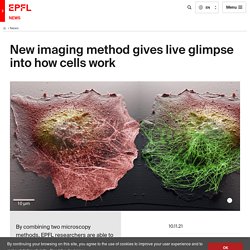
Cells are the fundamental component of living organisms and play host to a number of complex biological phenomena. Researchers need to be able to study these phenomena in detail in order to comprehend certain kinds of disorders and diseases and then develop effective treatments. Resolving chromatic aberration in refracting lenses. Light travels at different speeds based on the medium it passes through.
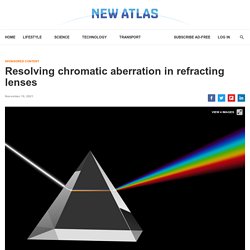
For example, in a vacuum, it travels at 3.0 × 10^8 m/s in a straight line. But when directed towards glass, air, diamond, water, and other mediums, it moves slower. The refractive index is used to show the speed of light in a vacuum in relation to the speed of light in a particular medium. The higher the measure, the slower the light moves in the given medium. Lenses and The Refraction of Light. Global brainstorm to identify Alzheimer’s disease risk. Scientists unite BRAINSTORM unites scientists from CERA, KU Leuven University, Belgium and Umeå University, Sweden and collaborators from University College, London.

The Victorian Brain Bank at the Florey Institute of Neuroscience and Mental Health and Lions Eye Donation Service will also be involved – providing tissues generously donated by people with Alzheimer’s disease and neuropathological diagnosis in an effort to advance the detection and treatment of the disease. The team will be funded over the next three years by Australia’s National Health and Medical Research Council and the European Union’s Joint Programme in Neurodegenerative Disease Research. Their support for the project recognises how international collaborations drive advances in health and medical research, accelerating progress by pooling skills and resources, and reducing duplication.
Powerful impact *This story first appeared in the CERA Annual Review for 2020. Titanium dioxide: E171 no longer considered safe when used as a food additive. Biomarkers could spell the end of anorexia nervosa. Researchers from the Swinburne Anorexia Nervosa (SWAN) Research Group have discovered what is believed to be the first biomarker for anorexia nervosa.
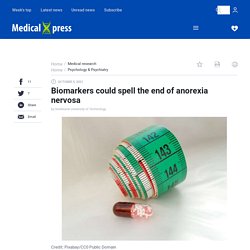
Biomarkers are typically used in the detection and treatment of physical illnesses, but never before have they been used in mental disorders. The challenges of diagnosis Anorexia nervosa is a life-threatening eating disorder that generally begins in early adolescence. It is often secretive and associated with persistent denial of symptoms and resistance to treatment. It has the highest mortality rate of all mental illnesses and low rates of recovery. Xiaomi Unveils Xiaomi Smart Glasses – Mi Blog. The next generation of glowing plants. Using specialized nanoparticles embedded in plant leaves, MIT engineers have created a light-emitting plant that can be charged by an LED.
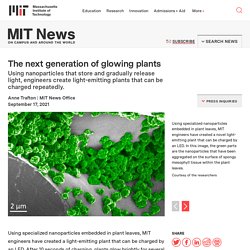
After 10 seconds of charging, plants glow brightly for several minutes, and they can be recharged repeatedly. These plants can produce light that is 10 times brighter than the first generation of glowing plants that the research group reported in 2017. “We wanted to create a light-emitting plant with particles that will absorb light, store some of it, and emit it gradually,” says Michael Strano, the Carbon P. Dubbs Professor of Chemical Engineering at MIT and the senior author of the new study. A contact lens for the ear. According to the German association for the hearing impaired – Deutscher Schwerhörigenbund e.V – some 15 million Germans are hard of hearing.

In many cases, hearing aids can improve hearing ability and simplify the day-to-day lives of those affected. With most standard hearing devices, the loudspeaker sits inside the wearer's ear canal. This produces acoustic distortions that can impair sound quality. The microphone is positioned behind the ear where it is susceptible to noise interference such as wind. Home page news - Imaging at the tip of a needle - University of Exeter. Scientists have developed a new technique that could revolutionise medical imaging procedures using light.
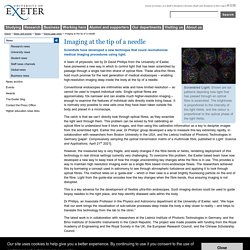
A team of physicists, led by Dr David Phillips from the University of Exeter, have pioneered a new way in which to control light that has been scrambled by passage through a single hair-thin strand of optical fibre. These ultra-thin fibres hold much promise for the next generation of medical endoscopes – enabling high-resolution imaging deep inside the body at the tip of a needle.
Conventional endoscopes are millimetres wide and have limited resolution – so cannot be used to inspect individual cells. Single optical fibres are approximately 10x narrower and can enable much higher-resolution imaging – enough to examine the features of individual cells directly inside living tissue. It is normally only possible to view cells once they have been taken outside the body and placed in a microscope. Let there be light! New tech for night vision - ANU. Researchers from The Australian National University (ANU) have developed new technology that allows people to see clearly in the dark, revolutionising night-vision. The first-of-its-kind thin film, described in a new article published in Advanced Photonics, is ultra-compact and one day could work on standard glasses. The researchers say the new prototype tech, based on nanoscale crystals, could be used for defence, as well as making it safer to drive at night and walking home after dark. One step towards a daily-use deep UV light source for sterilization and disinfection.
Osaka, Japan - Researchers from the Graduate School of Engineering and the Center for Quantum Information and Quantum Biology at Osaka University unveiled a new solid state second-harmonic generation (SHG) device that converts infrared radiation into blue light. Light-shrinking material lets ordinary microscope see in super resolution. June 1, 2021 -- Electrical engineers at the University of California San Diego developed a technology that improves the resolution of an ordinary light microscope so that it can be used to directly observe finer structures and details in living cells. The technology turns a conventional light microscope into what’s called a super-resolution microscope. It involves a specially engineered material that shortens the wavelength of light as it illuminates the sample—this shrunken light is what essentially enables the microscope to image in higher resolution.
> Item Display. In an effort to increase agricultural productivity and limit waste, a team of researchers from the Hebrew University of Jerusalem (HU)’s Robert H. Smith Faculty of Agriculture, Food and Environment developed a method to detect signs of stress before the plant is damaged. Plants are exposed to all types of weather and other external factors that cause harm and impact plants’ ability to undergo photosynthesis and produce fruit. If farmers could get an early warning sign that their plants weren’t doing well, this would help them take measures to protect their produce, prevent significant losses and safeguard national food sources. Researchers see atoms at record resolution. For the First Time, Optogenetic Therapy Partially Restores Patient’s Vision.
From the Foot Perspective: TU Graz Develops Algorithm for Shoe-Based Blind Assistance System. A shoe that tells you where to go. With a zap of light, system switches objects’ colors and patterns. When was the last time you repainted your car? Citrus derivative makes transparent wood 100 percent renewable. Published May 04, 2021. Mexicanos eliminan el coronavirus en un 99.9% con luz ultravioleta. Ante el regreso a actividades presenciales en oficinas, además de la preparación para el regreso a clases dentro de aulas educativas, expertos mexicanos han desarrollado una iluminación que ha logrado eliminar el nuevo coronavirus , causante de la enfermedad Covid-19, que está en el aire de espacios cerrados en un 99.9 por ciento.
El ingeniero Julio César Molina, Jefe del Laboratorio del Centro de Tecnología en Iluminación de la Universidad Autónoma de Guadalajara, aseguró que en la revisión al sistema de iluminación desarrollado por la firma Construlita se obtuvieron resultados benéficos tanto contra el SARS-CoV-2 como para otros patógenos, como bacterias y microorganismos, tales como Legionella pneumophila, Shigella paradysenteriae, Staphylococcus albus, Streptococcus viridans, y Eberthella typhosa, entre otros. Gene therapy research repairs nerve transport systems damaged by glaucoma and dementia. Results of the pre-clinical study, led by Professor Keith Martin from the Centre for Eye Research Australia and University of Melbourne and Dr Tasneem Khatib from the University of Cambridge, are published today in Science Advances. Researchers say the findings in experiments on mice show promise for developing new gene therapies to treat both glaucoma and dementia.
But critically, the findings also demonstrate how gene therapies could treat complex neurodegenerative diseases that are caused multiple factors rather than a single genetic fault. Micro-molded ‘ice cube tray’ scaffold is next step in returning sight to injured retinas. The indestructible light beam. 12. April 2021 Researchers at Utrecht University and at TU Wien (Vienna) create special light waves that can penetrate even opaque materials as if the material was not even there. Saarland University. What Does Your Gaze Reveal About You? On the Privacy Implications of Eye Tracking. Covid Tip Sheet: Scientists Use Ultraviolet Light to Disinfect CT Scanners.
InnerPlant – Making living sensors. AI-Powered Backpack Helps Visually Impaired Navigate World. No eyes? No problem. Worms still avoid the blues. Four causes for ‘Zoom fatigue’ and their solutions. Edible holograms could someday decorate foods. An optical coating like no other : NewsCenter. Remyelinating drug could improve vision in patients with multiple sclerosis.
Investigadores buscan identificar problemas de miopía mediante el uso de algoritmos de inteligencia artificial. A Rift in the Retina May Help Repair the Optic Nerve. Development of the first biohybrid artificial retina built with silk fibroin and retinal cells. Gene therapy injection in one eye surprises scientists by improving vision in both. Introducing EyeQue VisionCheck 2 – the World’s Most Powerful Do-It-Yourself Smartphone Vision Test. Vision Revision. Study shows promising material can store solar energy for months or years. Scientists develop new gene therapy for eye disease - Trinity News and Events. Institute - Contact Lenses For Diagnostic and Therapeutic Use.
New 3D colour X-rays made possible with CERN technology. This startup wants to replace the white cane for blind people. Turning Trash into Treasure: The Ocean Cleanup Sunglasses. Opening eyes to a frontier in vision restoration - Monash University. Shining a Green Light on a New Preventative Therapy for Migraine. Biomarker Indicating Neurodegeneration Identified in the Eye. Engineers produce a fisheye lens that’s completely flat. Amherst Scientists Invent New Sensing Eye Mask. U of T Engineering researchers develop cell injection technique that could help reverse vision loss - U of T Engineering News.
Scientists Use Nanoparticle-Delivered Gene Therapy to Inhibit Blinding Eye Disease in Rodents. Chemists create the brightest-ever fluorescent materials. -Developed New Class of Laser Beam Doesn’t Follow Normal Laws of Refraction. Nanostructures Modeled on Moth Eyes Effective for Anti-Icing - AIP Publishing LLC. Using artificial intelligence for early detection of keratoconus. Scientists restore vision to blind rats for 8 months with artificial retina. Exercise Can Slow or Prevent Vision Loss, Study Finds. New Eye Drops May Prevent a Common Cause of Blindness. Declining eyesight improved by looking at deep red light. - Solar Orbiter makes first close approach to the Sun. HKUST Scientists Develop World's First Spherical Artificial Eye with 3D Retina.
Scientists engineer human cells with squid-like transparency. Previously claimed memory boosting font “Sans Forgetica” does not actually boost memory. Multifunctional e-glasses monitor health, protect eyes, control video game. Inexpensive retinal diagnostics via smartphone — Universität Bonn. Smartphone app to help assess anemia by taking a picture of a person’s eyelid. New Ultrafast Camera Takes 70 Trillion Pictures Per Second. Sustainable light achieved in living plants.
AI-supported test for very early signs of glaucoma progression. New gene therapy tested in patients - LMU Munich. ‘Primitive’ Stem Cells Shown to Regenerate Blood Vessels in The Eye. New electrically activated material could improve braille readers. Eye blinking on-a-chip. High-Tech Contact Lenses Correct Color Blindness. Performs first-ever CRISPR gene editing within human body.
New genes predict glaucoma risk. Smart Contact Lens Sensor Developed for Point-Of-Care Eye Health Monitoring. Small eye movements are critical for 20/20 vision : NewsCenter. Compound eyes for industry and smartphone. Protein closely linked to commonest cause of blindness. Helper Protein Worsens Diabetic Eye Disease.
Research News - Self-moisturising Smart Contact Lenses. Pico Interactive and Tobii Announce World’s First Commercial Standalone VR Headset with Native Eye Tracking. NovaSight and Tobii Demonstrate Solution for Treating Amblyopia — the Leading Cause of Vision Loss in Children. VR is not suited to visual memory?! New robotic lens lets you zoom in by blinking your eye. Honey, I shrunk Michelangelo's David. More than meets the eye: Bosch enables the next generation of smartglasses - Bosch Media Service.
Researchers discover when it’s good to get the blues. The first stand-alone contact lens with a flexible micro battery. Crean un bastón inteligente con Google Maps para personas con discapacidad visual. A high-precision instrument for ophthalmologists - EPFL. New cell regeneration technology helps restore eyesight - Berkay Ozcelik - Australia Unlimited. Mapping eye disease. An artificial retina that could help restore sight to the blind. Thin to win.